A Fairy Tale in Tuvalu
The Tuvalu Series > Fongafale > Dot Tv > Fairy Tale > The End of the World
The news business is a lonely business, the Captain will often say. Many evenings he can be seen counting his best friends, one bottle at a time, in his refrigerator. The hours are long and the rewards few. Still, he moves forward, getting the news to the people.
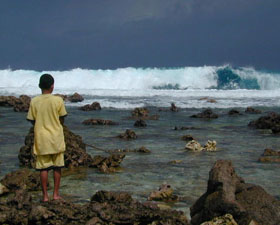 Sometimes this means traveling. This week he finds himself in the Polynesian nation of Tuvalu. Why not have a drink with him at the lagoon's edge? The fruity ones come with umbrellas.
Sometimes this means traveling. This week he finds himself in the Polynesian nation of Tuvalu. Why not have a drink with him at the lagoon's edge? The fruity ones come with umbrellas.
The film Tuvalu, a low budget German film from four years ago, unfolds on the screen like a dream. It is a nearly silent film of pure science-fiction fantasy that takes place in a dark industrial world of rough landscapes and blue colors. The story centers on a European bathhouse, where a mix of love and conspiracy eventually force the female lead character to dream of setting sail for the peaceful South Pacific island nation of Tuvalu. The film culminates in a desperate bid to save the bathhouse from a flood.
Tuvalu's intended irony is clear; the dreamer wishes to escape her world, threatened by flood, to the isolated nation of Tuvalu - a land of nine coral atolls that has in the last decade told the world its story of how it will likely be one of the first victims of sea-level rise caused by global warming.
But the film's story is a fairy tale. And very likely so is the nation's.
Getting the word out about Tuvalu's supposed plight has been easy. It is the classic David and Goliath battle. Big, bad industrial nations are sending carbon-based gases into the atmosphere at a rate swift enough to cause a warming of the globe and, as a result, a melting of the polar ice caps. The theory is that more water means higher ocean levels and small low-lying places like tiny defenseless Tuvalu (without a landform over 4.6 meters) will eventually be washed over.
The facts are, though, that the sea levels haven't been shown to be rising, at least not anywhere near Tuvalu, and long-term monitoring results have shown them to instead be falling. But Tuvalu does indeed have significant problems - enough for it to one day relocate its people. Most center on the fact that it is of very limited size and resources. It is the rising effects of these issues - and not the rising sea - that now confront Tuvalu.
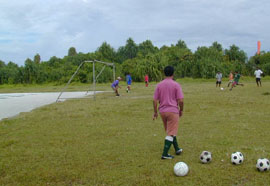 In many ways Tuvalu is the picturesque South Pacific nation; stiff ocean breezes shake coconuts from trees; turquoise waves crash on the shore stirring up broken bits of coral; and, sunsets are often punctuated with as many as a half dozen shades of red.
In many ways Tuvalu is the picturesque South Pacific nation; stiff ocean breezes shake coconuts from trees; turquoise waves crash on the shore stirring up broken bits of coral; and, sunsets are often punctuated with as many as a half dozen shades of red.
Tuvalu is small, of that there is no doubt. Located about two hours by plane north of Fiji, its roughly 11,000 people live on a total land area of 26 square kilometers - only the Vatican City, Monaco and Nauru are smaller. Children play soccer on the grass at one end of the airfield because it is the largest cleared open space available. The C-shaped atoll of Funafuti, home to roughly half the country's population, can be traveled lengthwise in about 20 minutes on a motorbike. Its width - from lagoon to ocean - in maybe 1 minute, at its widest point.
Tuvalu's surrounding sea levels - and those around the world - are influenced mainly by changes in sea temperature brought on by seasonal cycles and such phenomena as El Nino (an event of warm water currents). A smooth or linear increase or decrease in sea-level is not something that generally occurs. Fluctuations are more the norm.
The AusAID-sponsored South Pacific Sea Level and Climate Monitoring Project installed a monitoring station at Funafuti in the early '90s. The June 2002 report said that over the first few years, the station showed an increasing short-term trend in sea-level. But over the past four years, the trend rapidly switched to that of a decline, mainly due to the El Nino of 1998. It wasn't until the middle of last year that the trend returned once again to a positive trend (0.9 mm/yr). Satellite data from the TOPEX/Poseidon satellite gave similar results, also showing the strong influence of the El Nino in 1998. A study done by the University of Hawaii showed a slight increase for the past 22 years and a study going back 50 years showed a decrease of 4 inches for Tuvalu.
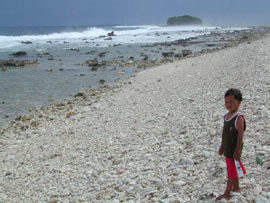 Still, journalists - lacking any sort of evidence - have taken Tuvalu's sea-level rise story and run. Magazines, television stations, and newspapers have buzzed around Funafuti - Tuvalu's island capital - like bees to a hive over the past few years, hoping to get a glimpse of the world's first "environmental refugees." Just last week, Japan's Asahi Television sent a news crew to document the situation. The government of Tuvalu has obliged all of the journalists, dutifully telling of the need for future relocation (set to begin with 75 people this year to New Zealand) and possible lawsuits against the polluting countries.
Still, journalists - lacking any sort of evidence - have taken Tuvalu's sea-level rise story and run. Magazines, television stations, and newspapers have buzzed around Funafuti - Tuvalu's island capital - like bees to a hive over the past few years, hoping to get a glimpse of the world's first "environmental refugees." Just last week, Japan's Asahi Television sent a news crew to document the situation. The government of Tuvalu has obliged all of the journalists, dutifully telling of the need for future relocation (set to begin with 75 people this year to New Zealand) and possible lawsuits against the polluting countries.
In an opinion piece, the Japan Times says that "it's too late for Tuvalu" and the people are "packing their bags as their homes among nine low-level atolls are being swallowed by the rising sea." The Daily Yomiuri writes in an editorial on politics and the global warming debate that Tuvalu's shorelines are being eroded and its homes inundated by water due to sea-level rise. The Washington Post claims that "Tuvalu is developing concrete emigration plans to evacuate its islands...This is because scientists say sea-level rise could inundate Tuvalu and other low-lying countries almost entirely as polar ice melts and ocean water expands."
Do Tuvaluans themselves see global warming as being a threat to their life and culture?
"I would agree with people that say that climate changes could be taking place," says Paulson Panapa, a heavy-set 35-year-old clerk in Tuvalu Parliament. "But not sea-level rise."
Paulson has a good point. As for climate changes, the scientific community has speculated that it is possible for the emission of carbon-based gases to indeed potentially increase the number of hurricanes, cyclones, or El Nino conditions, and alter ocean temperatures. But once again there is still no conclusive evidence.
Proof of an increase in these events, though, would be significant. In 1972, hurricane Bebe swept over Tuvalu entirely, wiping out nearly every structure.
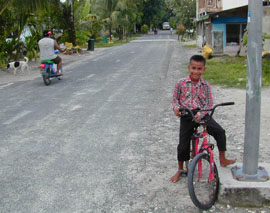 Paulson gives a recent example that shows how precarious Tuvalu's situation can be. On August 12th of this year, a large surge washed ashore and inundated a number of homes just south of Funafuti's airfield.
Paulson gives a recent example that shows how precarious Tuvalu's situation can be. On August 12th of this year, a large surge washed ashore and inundated a number of homes just south of Funafuti's airfield.
"Whenever there is some kind of seismic event or below the surface landslide in the Tonga Trench, we might get some kind of surge or wave," Paulson explains. "I don't know for sure what happened but that is what probably did happen. It was a clear day. There was no storm or anything."
However, he says the main reason for the inundation was something else entirely. In that area, people had been digging away sections of the seawall along the ocean. This was the entry for the water.
With Funafuti being small, building materials are scarce. Folks collect coral rocks from around the shore and use them for the construction of the foundations for buildings. Sand to be used in concrete is mined from the lagoon. It is because of this that Tuvalu's shorelines are eroding.
If sea-level rise isn't taking place, what is the real reason that people are beginning to leave for New Zealand? "People are looking for a new life," offers Paulson.
Tuvalu's current GDP is very limited; its fishing waters are licensed to foreign vessels; its postage stamps are sold to collectors; "1-900" phone numbers are routed through its international access code for use by phone sex operators; and, it receives US $4 million annually from its infamous sale of its Internet domain (.tv) to an American company. With the latter income a new set of tar-sealed roads with streetlights was completed on Funafuti this year, and in 2000 Tuvalu began paying its dues as the 189th member of the United Nations.
Most traditional industries are hurting. Tourism is limited to just over 100 visitors a year, and the copra (dried coconut) market has collapsed.
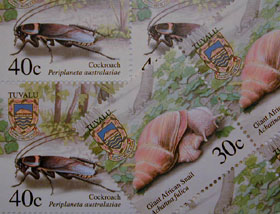 Additionally, over the past decade, thousands of phosphate miners - once working in Nauru's now closed mines - have migrated back to Funafuti in search of employment. With space already being tight, this migration and the present 1.5% population growth rate further exacerbates existing problems. Inescapable mounds of garbage pile up in pits on the north and south ends of Funafuti. Outside of fish, almost all food must be imported as nearly none of the land is arable for crops. Potable water is generally limited to rainwater caught with roof catchments.
Additionally, over the past decade, thousands of phosphate miners - once working in Nauru's now closed mines - have migrated back to Funafuti in search of employment. With space already being tight, this migration and the present 1.5% population growth rate further exacerbates existing problems. Inescapable mounds of garbage pile up in pits on the north and south ends of Funafuti. Outside of fish, almost all food must be imported as nearly none of the land is arable for crops. Potable water is generally limited to rainwater caught with roof catchments.
Given these conditions, the emigration to New Zealand then is not a part of an evacuation plan. Rather, it is a means to expand employment opportunities (only Tuvaluans under 45 years old and with English proficiency are eligible). For New Zealand, it is a way to legalize some of the illegal immigration that already is taking place from Tuvalu.
Still, life in Funafuti goes on at its nice and slow pace. Content to go about their daily work in the few small general stores or in their homes, most of the locals are not worried about sea-level rise, now or in the future. News that a new journalist has registered at Funafuti's one hotel is often greeted with a shake of the head and such comments as, "Another one?"
Paulson thinks he knows the reason for their lack of concern. "About 99% of Tuvaluans are Christians," he says. "They have faith in The Bible - and The Bible says that there will never be another flood. That is what Tuvaluans believe."
The Tuvalu Series > Fongafale > Dot Tv > Fairy Tale > The End of the World

